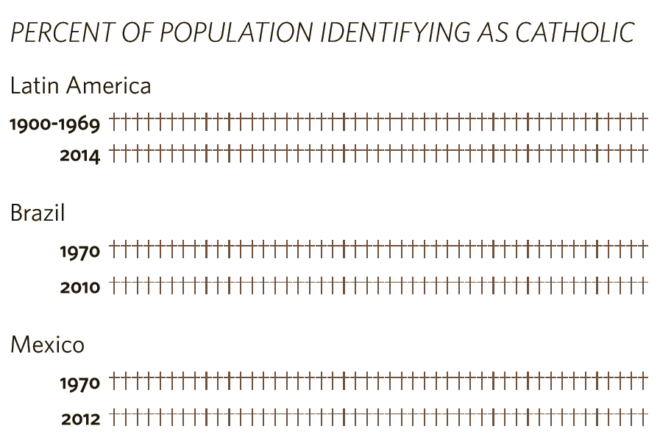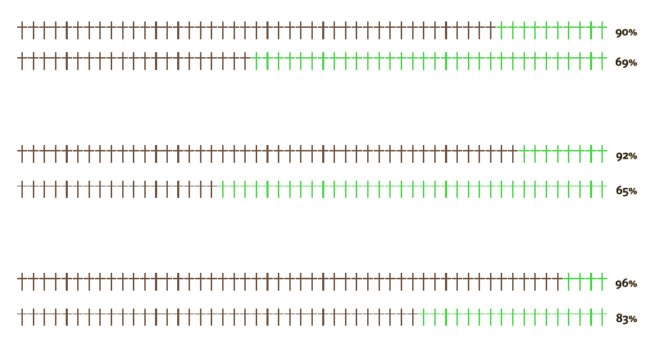Spreading the Word: Latin America’s Shift Away From Catholicism
Ever since missionaries descended on Latin America during the European colonization of the 16th and 17th centuries, Catholicism has been the dominant religion of the region, from Puerto Rico to Chile. Home to 425 million Catholics, Latin America is home to over 40 percent of the world’s Catholic population. Brazil and Mexico boast the world’s two largest Catholic populations. It isn’t hard to see why in 2013 the Catholic Church elected Pope Francis from Buenos Aires, Argentina to lead its 1.2 billion faithful.
However, developments that span only a generation demonstrate a shift in religious practice away from the Catholic Church and towards “Evangelicos,” the name given to the primarily Pentecostal Christians that have increased dramatically in number. Today, nearly 1 in 5 Latin Americans identify as Protestant (the majority being Pentecostal). This shift is recent and ongoing: according to a Pew survey, one out of every three current Protestants was raised Catholic and over half were baptized in the Catholic Church.
What can help explain this unprecedented change in religious identity?
The Protestant Church is Less Political
In the 1970s and 1980s, the Catholic church developed an ideology known as liberation theology. Catholic leaders called upon religious imagery and rhetoric to inspire Latin Americans to confront authoritarian regimes, such as the military dictatorships in Argentina and El Salvador. Linking the language of the bible with political activism and issues of poverty, justice, and oppression, liberation theology motivated many to rise up in resistance. However, the carnage and death that followed these resistance movements pushed Latin Americans away from the highly politicized Catholic Church and toward Protestantism, with its heavier focus on personal salvation. This emphasis on the individual offered converts a deeper attachment to the church, as well as an alternative to Catholic congregations that often did not have the resources to educate their congregants in the faith.
Protestantism Focuses on Health and Healing
Pentecostalism and Neo-Pentecostalism specifically emphasize faith healing, which draws in many converts suffering from illnesses. Despite the region’s push toward universal health coverage, 51% of Latin America’s population does not receive formal health care due to economic or geographical obstacles. The massive inequities in healthcare access make these informal, spiritual health sectors invaluable. Furthermore, a large demographic of Latin America’s urban poor suffer from substance abuse and addiction. Pentecostalism stresses heavy lifestyles, and its churches offer some of the largest rehabilitation and detox centers in Latin America. While the centers are free to patients (and in some cases in Guatemala, involuntary, as addicts are taken off the streets against their will), the programming includes an acceptance of the Pentecostalist faith. These programs range in size, intensity, and radicalness, but generally follow the model of secular rehabilitation (a rigorous schedule of chores, counseling, and work duties), with the major difference of perceiving addiction as a sin rather than an illness. Accordingly, internees are encouraged to find God in mercy and discover their value in the eyes of God. To this end, programming can include bible study classes, baptisms, and speaking in tongues, which is when a member of the faithful is miraculously gifted the ability to speak a language otherwise not known to them.
Pentecostalist Priests Tend to be Local
Protestant church-goers also tend to have an easier time connecting with their religious leaders, as the shortage of Catholic priests in Latin America means many are “imported” elites from Europe, and are usually white or Mestizo. The shortage of priests in the Catholic Church has always been a problem, a product of the rigorous and long-term training period. By contrast, evangelical priests in Latin America are widely uneducated and local, since one does not need nearly as much formal training to become a priest in a Pentecostalist or Neo-Pentecostalist church. Their abundance, responsiveness, and integration in the community make for a more “homegrown” religion.
Initially, a change from one denomination of Christianity to another may not seem like a significant shift. But as the Catholic Church continuously struggles to adapt and keep up with the needs of its followers, a shift this large in a region that was once seen as a Catholic stronghold is noteworthy and telling, and concerning for the Vatican. No matter the reason of a personal conversion to Pentecostalism, the movement away from Catholicism represents the Church’s eroding ability to connect with its previous members, and suggests that it should not take its dominance in the region for granted.
The success of Evangelicals in Latin America also generates debate surrounding the effects of missionary work and proselytizing on society, especially within indigenous populations. In some ways, the promises of services such as medical care are reminiscent of the “development” brought by Catholic missionaries centuries ago,and the ways in which colonization was justified as serving indigenous communities. And in countries where large portions of the population face poverty and a lack of access to basic services, the connection of religion to social support has inherently political consequences. Only time will tell the effects this religious shift will have on Latin America, but it is clear that change has already begun.

